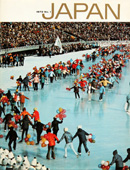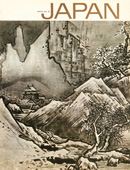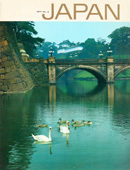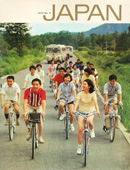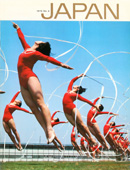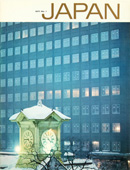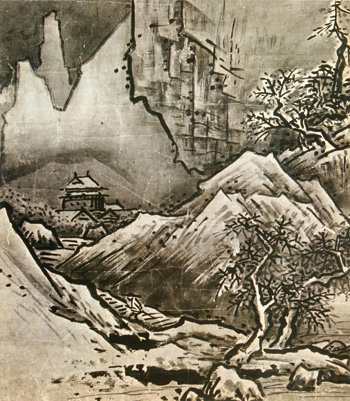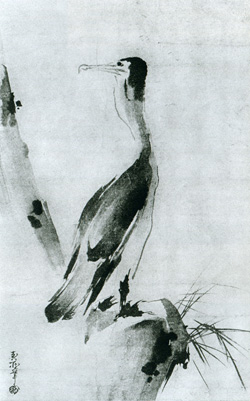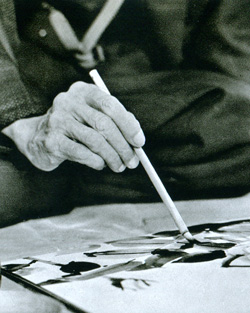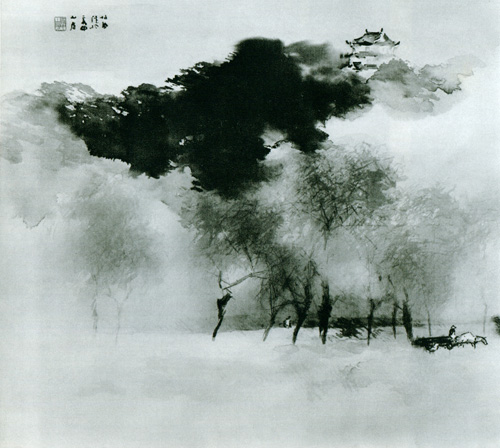<
Back to Documents
< Previous
Next >
Japan - A Journal Published by The Japanese Ministry of Foreign Affairs - Back Issues from the 70s
***
Japan is a quarterly journal which was published by the Japanese Ministry of Foreign Affairs in the 60s and 70s. This beautiful profusely illustrated magazine was published in cooperation with the Mainichi Newspapers and includes cover stories about Japanese government policy, social and economic trends, scientific and technological breakthroughs as well as interesting articles about Japanese history, culture and art. The first issue of Japan was published in 1963. In the following we present snapshots of the beautiful front covers of some of the back issues we have, which were published in the early 70's:
חריצות ונחרצות איפשרו לעם היפני לשקם ולקומם את ארצו מחורבותיה לאחר מלחמת העולם השניה ולהפוך את יפן לנס כלכלי. בשנות ה-60 וה-70 הייתה יפן מעצמה טכנולוגית המכוונת פניה אל השוק העולמי של מוצרי הצריכה. "סוני" שרכשה את זכויות הרישוי של הטרנזיסטור מ"ווסטרן אלקטריק" האמריקאית, יצרה במרץ דגמים חדשניים של מקלטי רדיו, טלוויזיה ומערכות שמע, תעשית המצלמות היפנית הפכה לשם דבר וניצני המכוניות הקטנות והמשובחות מארץ השמש העולה החלו לפרוח.
ההכרח לחדור לשווקים ולרכוש את ליבם של קהל הצרכנים הפוטנציאלי היווה תמריץ למשרד החוץ היפני לפתוח במערכה לשיקום ולבניה מחדש של תדמיתה של האומה היפנית בעיני אזרחי העולם המערבי דוברי האנגלית. עיקר המאמץ היה למצוא חן בעיני האמריקאים שאליהם הפנתה יפן את מוצרי הצריכה האלקטרוניים שיצרה. הרבעון "יפן" Japan שיצא לאור באנגלית מטעם משרד החוץ של יפן The Ministry of Foreign Affairs of Japan, היה נדבך חשוב במאמץ לשכנע את הצרכנים הפוטנציאלים שיפן והיפנים הם עם חרוץ ועדין בעל תרבות עשירה, שהטמיע את ערכי החיים הטובים של העולם המערבי ומרגיש חלק ממנו - לא עוד אותו אויב עקשן, זר ומוזר מן המזרח שהקיז את דמם של מאות אלפי חיילים אמריקאים. כל חוברת של "יפן" היתה מלאכת מחשבת של הפקה מגזינית מן הדרגה הגבוהה ביותר החל מאיכות הנייר, ההדפסה והתמונות וכלה בחומר הכתוב. המאמרים, באנגלית מושלמת, האירו את הפנים השונים של האומה היפנית, מדע, תרבות, ספורט ואמנות, באור שהקל על הקונה האמריקאי להעדיף את התוצרת היפנית המשובחת מבלי להרגיש שהוא בוגד במדינתו.
Since the surrender of Japan after World War II and the signing of the Treaty of San Francisco, Japanese diplomatic policy has been based on close partnership with the Western world's countries especially the USA. In the rapid economic developments of Japan in the 1960s and 1970s, great efforts were invested in re-gaining a leading position and recovering the Japanese influence.
As part of these efforts, the Ministry of Foreign Affairs of Japan initiated and sponsored the Japan magazine, targeted at English speakers. The magazine, printed on a glossy high quality paper included pictorial reportages and articles that presented Japan's glorious cultural tradition together with its adopted modern Western oriented life style in a way which was intended to attract Western readers. Copies of the magazine were distributed to key opinion leaders in the Western world by a network of diligent officers in the Japanese embassies world wide. A typical list of the articles which were published in the early 70's may best give you the scope of issues covered as well as the directions this public relations campaign took:
- Cooperation for Development - Japan's Foreign Aid Program
- First and Greatest - EXPO 70 Closes Amidst Cheers and Tears
- Suiboku Painting - Unique Genre of Oriental Art
- Miss Keiko Kuyama: A First in Symphonic Conducting
- Japanese Stamps - Art and Utility Combined
- Japan Robots with "Senses"
- Nagoya - Queen City of Central Japan
- Soaring Through the Sky - New Popularity for Glider
- The Sapporo Winter Olympics
- City Banks Grow with Economic Expansion
- Kiyoko Nakayama "Master Craftsman"
- The Ancient Abacus - Faster Than an Electronic Calculator
- Pottery of Japan - A Tradition of Excellence
- Fascination of Noh Plays
- Sea Angling for Leisure-Time Thrills
- Sendai City - Former Castle Town is Bustling, Prosperous Metropolis
- Hokkaido - Japan's Last Frontier
- Age of the High-Rise Building Begins
- Shiko Munakata - Master Artist of the Woodblock Print
- Notes and Coins of Japan
- Glamour Girl of Bowling - Ritsuko Nakayama
- Kanazawa - Historical Japan Sea Cost City
- The Emperor and Empress of Japan
- The Calligraphic Art of Shodo
- The Simultaneous Interpreter: New Profession for Women
- Pottery of Japan - A Tradition of Excellence
- Seto Inland Sea and Its Scenic Wonders
- Kyudo - Ancient Sport of Archery
- Swans: Japan's "Angels" of Winter
- Okinawa - A Dream Comes True
- Fruit Paradise - All Temperate Varieties Abundant in Japan
- Carving in Granite - Tradition of Ancient Stone Cutters Carried On
- Sport of Beauty and Skill - Women Gymnasts
- Japanese Confections
- A new Look for An Old Art - Paper Sculpture Based on Origami
- Okayama City - Visions of Ancient Castle Town
- Japanese Sweets are Made with Sophisticated Sense
- Japan's Newspapers - Quality Dailies with Huge Circulations
- Asuka - Treasure-House of Ancient Culture
- Development of Tokyo Bay - Dynamic Beauty with Functionalism
- Motoko Ishii Injects New Ideas into Modern Lightning Design Art
- Cycling Boom - Easy Means of Recreation Increasingly Popular
- Japan's Famed Optical Lens Industry - Performance Enhanced by Use of Computers
- The Kiso Route - One of Japan's Historic Highways
Issue No 4 of Japan, published on winter of 1970, introduced a beautifully illustrated article on Suiboku Painting - The Unique Genre of Oriental Art from which we collected the following:
Stylized representation, delicate lines, simplicity of composition, ample spacing and beautiful tone are the characteristics of Suiboku painting, a unique genre of Oriental art that has produced many of the world's masterpieces of ink painting. Essentially monochrome painting, Suiboku expresses all the nuances of nature's color through various shades of black.
After it was introduced into Japan during the Kamakura Period (1192 - 1333) by Zen priests, Suiboku was combined in the Muromachi Period (1392 - 1573) with Japan's traditional painting style that had exited from olden times. This resulted in an original development whose foundation was laid by the noted Zen priest - artist, Sesshu (1420 - 1506). He passed the bounds of the traditional Chinese style by giving landscapes a perspective representation through the use of mighty strokes and different shadings of black. The shading nuance comprises, far more distinctly than in the Chinese original, the most substantial feature of the Japanese Suiboku tradition.
"Shuto Sansuize" (autumn - winter landscape), a two part Suiboku painting drawn by Sesshu in the 15th century
The sumi, or ink stick, plays a decisive role in distinguishing Suiboku from any other style of painting. Fully black, and made from the soot of burnt pine-wood or rapeseed oil combined with glue, the ink stick is dissolved in water by rubbing it calmly on the surface of a hard, flat ink stone called Suzuri. With differing quantities of water, different shading of black can be obtained.
"U" (Cormorant) by Musashi Miyamoto - a 17th century swordsman of great fame
The brush used in Suiboku is made of soft hair of various animals. By applying pressure, a heavy line can be drawn and, by gradually relieving the pressure, it can be tapered off into a delicate line. This is a technique that cannot accomplish with the oil painting brush. Nor can an oil painting brush produce the peculiar dark to black shading or the halo effect around the black which are so much a part of the Suiboku style.
The hand of Nampu Katayama, the painter of "Zuirya" (Lucky Dragon)
Suiboky can, in principal, be executed on almost any kind of Japanese paper, a unique product of long tradition using special sorts of fiber made from bark of different trees. Shiki-shi (literally colored paper), a thick card-board-type paper, and Gasen-shi (literally, drawing paper), a slightly thinner and water absorbent variety, are best suited for Suiboku painting with its indispensable shading-off effect.
The art and philosophy of Suiboku painting is distinctively Oriental. Austere in color and sparing in line, Suiboku is often considered philosophically parallel to Zen Buddhism, one of whose fundamental concepts is simplicity. Herein lies one reason why, since its emergence in China and its introduction in Japan, Suiboku has numbered among its devotees many Zen priests, who have produced some of the finest Suiboku paintings extant today.
"Chiyoda-jo" (Chiyoda Castel) by Seiho Takeuchi - 20th century
Just as Haiku, the uniquely Japanese form of poem, is only a few words long and merely suggests a thought or feeling, so do Suiboku painting consist of just a few lines that suggest an idea, an expression of the artist's feeling at the time he viewed the subject. In Western painting, black is only one of many colors. In Suiboku, however, it has long been considered that black, with its wide-ranging gradation of shadings, give expression to all the colors in nature.
Another characteristic of Suiboku is that great importance is attached to blank space. Nampu Katayama (1887 - 1980), a contemporary authority in Japanese painting and creator of the Suiboku masterpiece "Zui-Ryu" (Lucky Dragon) in the Chuzenji Temple in Nikko, said: "Suiboku painting omits, as far as possible, the lines and strokes which most styles of painting cannot dispense with. The fewer lines there are, the greater is the perfection of the Suiboku."
סגנון הציור היפני ה"סויבוקו" Suiboku אהוב עלי במיוחד. המונוכרומיות - השימוש בצבע אחד בלבד, כהה, בדרך כלל שחור, מאלץ את הצייר להתרכז ולנסות להבין את פנימיותו של נושא הציור ואז, כמו שאומר אלי לנצמן, לבטא את הבנתו ב"מכת חרב" מהירה שבה מושך הצייר במברשת הטבולה בדיו השחור ומפיק ממנה במהירות ובאופן מיידי את הגוונים וגווני הגוונים שמתארים את התרשמותו האישית והספונטנית מן המציאות המצוירת. הגוונים שבציור הם למעשה דרגות כהות שונות של צבע הדיו האחיד שאותן מפיק הצייר באמצעות שינויים מהירים של הזוית ולחץ היד האוחזת במכחול, ואכן כמה מן הציירים בסגנון הסויבוקו היו גם סייפים מאומנים.
החשוב מבין ציירי סגנון הסויבוקו הוא הנזיר וחכם הזן סאשו Sesshu שפעל ביפן בסוף המאה ה-15 והירבה לצייר ציורי נוף. יצירתו המפורסמת "ארבע עונות השנה" היא מגילה ארוכה, כ-16 מטר אורכה, שמתארת את המראות המשתנים של הנוף והטבע במסע מן האביב אל החורף. החלק העוסק בסתיו ובתחילת החורף מוצג על שערו של הרבעון "יפן" Japan משנת 1970. סאשו שלמד את יסודות ציור הנוף המונוכרומטי בביקוריו בסין, המשיך ופיתח את סיגנונו העצמאי הייחודי והעניק לנופים שצייר עצמה ומימד עומק באמצעות משיחות מכחול חזקות ומרחב גוונים עשיר ומודגש של הדיו.
Our collection of Japan back issues includes all issues from 1970 until 1972, most of them in a very good condition - an excellent treasure for the collector and researcher. If you are interested, contact me and I will send you further information including full description of the content of the copy, price and estimated shipping cost. We have many other interesting back issues of Japanese art magazines and art books which will be added frequently, so please keep checking. If you have something particular in mind that you are interested in, you are invited to write to me and describe the copy of your interest and I will check and send you an answer if something which matches your interests appears in my lists.
Soft cover: Various back issues of the "Japan" journal
Publisher: The Ministry of Foreign Affairs of Japan, Tokyo, (1970 - 1972)
Language: English.
Price: Call
Item: D1016 - Back issues of the Japan journal
© Dan Levy - Art Pane Home of Collectible Magazines
